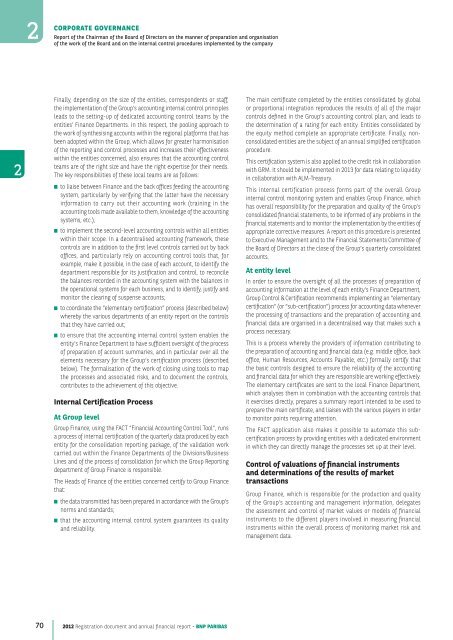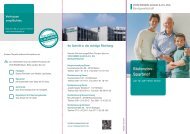2012 Registration document and annual financial report - BNP Paribas
2012 Registration document and annual financial report - BNP Paribas
2012 Registration document and annual financial report - BNP Paribas
- No tags were found...
Create successful ePaper yourself
Turn your PDF publications into a flip-book with our unique Google optimized e-Paper software.
2CORPORATEGOVERNANCEReport of the Chairman of the Board of Directors on the manner of preparation <strong>and</strong> organisationof the work of the Board <strong>and</strong> on the internal control procedures implemented by the c ompany2Finally, depending on the size of the entities, correspondents or staff,the implementation of the Group’s accounting internal control principlesleads to the setting-up of dedicated accounting control teams by theentities’ Finance Departments. In this respect, the pooling approach tothe work of synthesising accounts within the regional platforms that hasbeen adopted within the Group, which allows for greater harmonisationof the <strong>report</strong>ing <strong>and</strong> control processes <strong>and</strong> increases their effectivenesswithin the entities concerned, also ensures that the accounting controlteams are of the right size <strong>and</strong> have the right expertise for their needs.The key responsibilities of these local teams are as follows:■ to liaise between Finance <strong>and</strong> the back offices feeding the accountingsystem, particularly by verifying that the latter have the necessaryinformation to carry out their accounting work (training in theaccounting tools made available to them, knowledge of the accountingsystems, etc.);■ to implement the second-level accounting controls within all entitieswithin their scope. In a decentralised accounting framework, thesecontrols are in addition to the first level controls carried out by backoffices, <strong>and</strong> particularly rely on accounting control tools that, forexample, make it possible, in the case of each account, to identify thedepartment responsible for its justification <strong>and</strong> control, to reconcilethe balances recorded in the accounting system with the balances inthe operational systems for each business, <strong>and</strong> to identify, justify <strong>and</strong>monitor the clearing of suspense accounts;■ to coordinate the “elementary certification” process (described below)whereby the various departments of an entity <strong>report</strong> on the controlsthat they have carried out;■ to ensure that the accounting internal control system enables theentity’s Finance Department to have sufficient oversight of the processof preparation of account summaries, <strong>and</strong> in particular over all theelements necessary for the Group’s certification process (describedbelow). The formalisation of the work of closing using tools to mapthe processes <strong>and</strong> associated risks, <strong>and</strong> to <strong>document</strong> the controls,contributes to the achievement of this objective.Internal Certification ProcessAt Group levelGroup Finance, using the FACT “Financial Accounting Control Tool”, runsa process of internal certification of the quarterly data produced by eachentity for the consolidation <strong>report</strong>ing package, of the validation workcarried out within the Finance Departments of the Divisions/BusinessLines <strong>and</strong> of the process of consolidation for which the Group Reportingdepartment of Group Finance is responsible.The Heads of Finance of the entities concerned certify to Group Financethat:■ the data transmitted has been prepared in accordance with the Group’snorms <strong>and</strong> st<strong>and</strong>ards;■ that the accounting internal control system guarantees its quality<strong>and</strong> reliability.The main certificate completed by the entities consolidated by globalor proportional integration reproduces the results of all of the majorcontrols defined in the Group’s accounting control plan, <strong>and</strong> leads tothe determination of a rating for each entity. Entities consolidated bythe equity method complete an appropriate certificate. Finally, nonconsolidatedentities are the subject of an <strong>annual</strong> simplified certificationprocedure.This certification system is also applied to the credit risk in collaborationwith GRM. It should be implemented in 2013 for data relating to liquidityin collaboration with ALM-Treasury.This internal certification process forms part of the overall Groupinternal control monitoring system <strong>and</strong> enables Group Finance, whichhas overall responsibility for the preparation <strong>and</strong> quality of the Group’sconsolidated <strong>financial</strong> statements, to be informed of any problems in the<strong>financial</strong> statements <strong>and</strong> to monitor the implementation by the entities ofappropriate corrective measures. A <strong>report</strong> on this procedure is presentedto Executive Management <strong>and</strong> to the Financial Statements Committee ofthe Board of Directors at the close of the Group’s quarterly consolidatedaccounts.At entity levelIn order to ensure the oversight of all the processes of preparation ofaccounting information at the level of each entity’s Finance Department,Group Control & Certification recommends implementing an “elementarycertification” (or “sub-certification”) process for accounting data wheneverthe processing of transactions <strong>and</strong> the preparation of accounting <strong>and</strong><strong>financial</strong> data are organised in a decentralised way that makes such aprocess necessary.This is a process whereby the providers of information contributing tothe preparation of accounting <strong>and</strong> <strong>financial</strong> data (e.g. middle office, backoffice, Human Resources, Accounts Payable, etc.) formally certify thatthe basic controls designed to ensure the reliability of the accounting<strong>and</strong> <strong>financial</strong> data for which they are responsible are working effectively.The elementary certificates are sent to the local Finance Department,which analyses them in combination with the accounting controls thatit exercises directly, prepares a summary <strong>report</strong> intended to be used toprepare the main certificate, <strong>and</strong> liaises with the various players in orderto monitor points requiring attention.The FACT application also makes it possible to automate this subcertificationprocess by providing entities with a dedicated environmentin which they can directly manage the processes set up at their level.Control of valuations of <strong>financial</strong> instruments<strong>and</strong> determinations of the results of markettransactionsGroup Finance, which is responsible for the production <strong>and</strong> qualityof the Group’s accounting <strong>and</strong> management information, delegatesthe assessment <strong>and</strong> control of market values or models of <strong>financial</strong>instruments to the different players involved in measuring <strong>financial</strong>instruments within the overall process of monitoring market risk <strong>and</strong>management data.70<strong>2012</strong> <strong>Registration</strong> <strong>document</strong> <strong>and</strong> <strong>annual</strong> <strong>financial</strong> <strong>report</strong> - <strong>BNP</strong> PARIBAS





